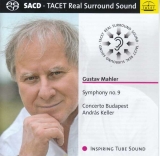In dieser Surround-Aufnahme mag Andras Keller dirigieren, für den Hörer ist das Team von Tacet für das Endergebnis nicht weniger wichtig. Ich habe schon so manche Tacet-Einspielungen im Real Surround gehört, aber diese erlaubt ein ganz besonders immersives Erlebnis, weil sie die Ausdrucksvielfalt der Musik verstärkt, die einzelnen Gesten deutlicher werden lässt, das Unerwartete und das Groteske betont. Der Hörer sitzt mitten im Orchester, das um ihn herum platziert ist, Trompeten und Schlagzeug vorne, Holz eine Reihe davor, also unmittelbar vor dem Hörer, während die Streicher genauso direkt hinter ihm sitzen. Außen links sind die Hörner, außen rechts die Posaunen und hinten die Tuba. Das ergibt ein ganz spezielles, ungewohntes Klangbild, das einem Mahlers Sprache jedoch sehr klar werden lässt.
Im ersten Satz fühlt man das Desolate und Mahlers Todesahnungen, im zweiten wird das Täppisch-derbe des Ländlers bestens zum Ausdruck gebracht.
Die Rondo-Burleske kommt sehr burschikos daher, und in der Dezidiertheit der Musik, positiv zu wirken, wird dann doch deutlich, dass das alles nur erzwungene Fassade ist, Galgenhumor, wie es Mengelberg formulierte. Der Beginn des letzten Satzes reißt uns sofort in die Welt des Abschieds zurück, die diese Symphonie wohl für Mahler bedeutete, ganz besonders in diesem Adagio-Finale, das Keller in fünfundzwanzigeinhalb Minuten erst zum Glühen und dann zum Ersterben bringt. Auch in diesem Satz ist der musikalische Tauchgang höchst intensiv, der Tod um einen herum zutiefst ergreifend, besonders wenn man die Musik mit geschlossenen Augen wie in einem Klangtunnel erlebt: Musik für einen perfekten Passagio.
In this surround recording, Andras Keller may conduct, but for the listener, the Tacet team is no less important to the final result. I’ve heard many a Tacet recording in real surround, but this one allows for a particularly immersive experience because it enhances the expressive variety of the music, makes the individual gestures clearer, emphasizes the unexpected and the grotesque. The listener sits in the middle of the orchestra, which is placed around him, trumpets and percussion in front, wood one row in front, that is, directly in front of the listener, while the strings sit just as directly behind him. On the outside left are the horns, on the outside right the trombones and in the back the tuba. This results in a very special, unusual sound image, but one that makes Mahler’s language very clear to one.
In the first movement, one senses the desolate and Mahler’s forebodings of death; in the second, the Täppisch-derbe of the Ländler is expressed in the best possible way.
The Rondo-Burleske comes across as very tomboyish, and in the music’s determination to seem positive, it then becomes clear that it is all just forced facade, gallows humor, as Mengelberg put it. The opening of the last movement immediately sweeps us back into the world of farewell that this symphony must have meant to Mahler, especially in this Adagio finale, which Keller makes glow and then die in twenty-five and a half minutes. In this movement, too, the musical dive is highly intense, the death around you deeply poignant, especially when you experience the music with your eyes closed, as if in a tunnel of sound: music for a perfect passagio.
























